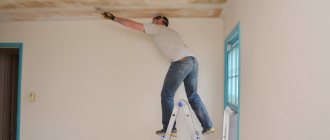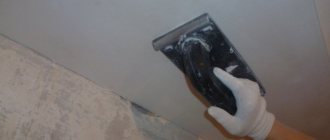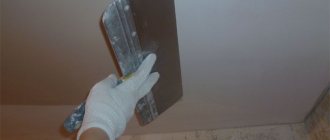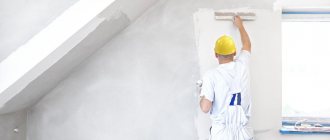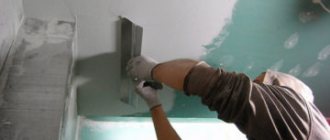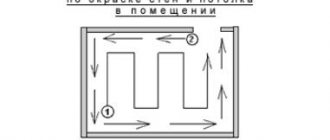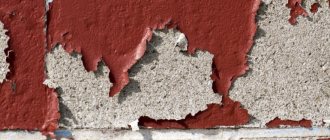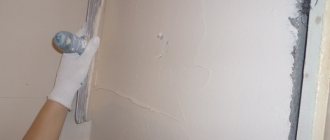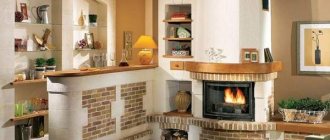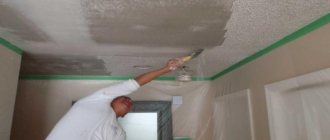Preparatory stage
Tools needed for putty
Tools and materials
During the puttying process you will need:
- dry putty mixture;
- mixing container;
- construction mixer;
- metal spatulas;
- roller or brush for priming;
- sandpaper;
- deep penetration primer.
putty
Two spatulas are enough - wide (400-500 mm) and narrow (70-100 mm), but it’s good if you also have a corner one, which is convenient for puttingtying the seams between the ceiling and walls. It is recommended to buy the dry mixture with a small reserve in order to correct possible defects if necessary.
Ceiling preparation
Cleaning the ceiling with a sander
The putty must be applied to a dry and cleaned surface, and therefore everything from the ceiling is removed to the very base. You can remove wallpaper and old layers of plaster using water: moisten the ceiling generously and leave for 10-15 minutes. After this, use a spatula to pry up the edge of the coating and remove it without much effort. Paint is more difficult to remove and requires a hammer drill. If the ceiling has been painted recently and the paint holds very firmly, you can not remove this layer, but simply smooth out the visible irregularities with sandpaper.
Ceiling primer
After removing the coating, the ceiling must be wiped with a clean cloth and then thoroughly primed, paying the greatest attention to the corners and joints. The primer will not only prevent the development of mold, but will also increase the adhesion of the putty layer to the base
If there are through gaps or cracks in the ceilings, as well as deep recesses, they must be sealed with a solution before treating the ceiling with a primer.
Sealing ceiling seams before puttying Using a spatula, the mesh must be leveled along the seam, pressing lightly so that the putty passes through the holes
This is interesting: Fiberglass wallpaper on the ceiling - how to glue it for painting, video and photo examples
Tools and materials
Tools for puttying.
To perform ceiling repair work you may need:
- spatula with an elastic flexible blade;
- dry gypsum putty (preferably Knauf, Uniflot);
- drill or hammer drill;
- masking tape;
- mixer attachment for drill;
- PVA glue;
- primer with deep penetration properties;
- fine-grain sandpaper or sanding mesh;
- construction pistol;
- acrylic sealant.
Ceiling putty technology
You can check the required degree of density of the mixture like this: take a little mixture on a spatula and turn it over. If the mixture is too thin, it will quickly drain from the spatula, and if it is too thick, it will simply remain on the inverted spatula.
If the resulting solution smoothly slides down from the spatula, it means that we have achieved the correct consistency and we can begin to putty.
- We take our mixture with a small spatula and put it on a large spatula.
- Next, we place a large spatula at the joint of the surface at a slight angle and pull it along the ceiling with a sliding motion until all the mixture from the spatula is on the ceiling. The thickness of the layer for the starting putty should not exceed 4 mm, for the finishing putty - 2 mm.
- We repeat the previous steps again: we collect putty and smear it on the ceiling. Make sure that all layers are applied equally and that there are no stripes left from the spatula. They must be rubbed down immediately so that the ceiling covering is intact.
Tips for puttying the ceiling
Work should start from the corner of the room or from the wall, and not from the middle. If you are trying to putty the ceiling yourself for the first time, then the initial section of a couple of meters will become a training area for you. Then you will get better at it, and the work will go faster.
When applying putty, you will need to use a stepladder to reach the ceiling. But a table will do. For a beginner, the table is even more convenient: you can walk on it and place available materials (mixture, spatulas) there.
After you have applied the mixture to the entire surface of the ceiling, it is left to dry. The manufacturer also writes on the packaging the drying time of the mixtures, usually about 24 hours.
After the mixture has dried, the surface is checked for unevenness and “flaws” using a portable lamp. We just direct additional light onto the surface and see how it turns out. If we are satisfied with everything, we proceed to sanding. If not, level the surface with the mixture again.
How to sand a ceiling after puttying
The ceiling must be sanded after puttying. Even if you have plasterboard ceilings. Or if the work was carried out by a professional, without sanding the ceiling will not look solid and smooth.
Sanding the starting layer of putty is done using a special device in the form of a trowel and sandpaper. Sanding is carried out with smooth circular movements, without strong pressure, so as not to leave unnecessary chips and stripes. Don’t forget to protect your hair with a scarf or cap, your eyes with safety glasses, and your respiratory tract with a respirator (a pharmaceutical mask will also do).
Now you can begin applying the finishing layer of putty to the ceiling.
How to apply finishing putty to the ceiling
- To do this, you first need to prime the sanded layer of starting putty again.
- Next, we dilute our finishing mixture (according to the instructions on the package).
- The technique for applying the finishing putty to the ceiling is the same as when applying the starting putty. The whole procedure is repeated: apply the mixture to the ceiling, wait for it to dry, and check with a lamp.
If everything is fine, we sand the ceiling, and you can begin the final finishing or painting.
How to mix putty correctly?
It is best to mix the putty in a bucket using a mixer, the role of which can be played by an ordinary drill with a special attachment for mixing the putty. It is very important that the bucket is always perfectly clean; after each use, it must be thoroughly washed with a steel wool so that there are no dried particles of the solution, which you will then drag back and forth across the ceiling, making endless scratches.
You need to mix a small amount of putty, which you will have time to work out before it starts to set. Gypsum solutions begin to set faster than others. It is strictly not recommended to dilute a solution that has begun to set with water, because its strength will suffer as a result. It’s better to mix less than to sculpt who knows what on the ceiling.
We hope these professional tips will help you cope with puttying ceilings yourself and save on the services of professional painters.
Putty for metal for outdoor work
Metal products are often used outdoors; external use regularly leads to the appearance of flaws, cracks, and dents on the surface. Puttying a metal surface makes it possible to remove all existing dents. If the process is carried out correctly, then you get an updated product without any irregularities. After the material has dried, the surface is painted or varnish is applied.
Puttying a metal surface makes it possible to remove all existing dents.
What are its features
You can get an acceptable result only by using high-quality metal putty. There are a number of characteristics that such a product should have. These include:
- Quick-drying property;
- Possessing high rates of adhesion to metal material;
- High degree of elasticity, retained even after completion of the hardening process;
- It lay evenly on the surface;
- Minimum shrinkage level;
- Convenience and ease of application;
- Since metal putty is often used for painting, it is necessary that it be combined with the paint.
Since metal putty is often used for painting, it is necessary that it be combined with the paint.
Why putty metal?
Before deciding how to putty metal, you need to figure out what purpose you should do it for. There may be several reasons for using putty:
- When car parts are scratched, broken, or damaged, they are treated with putty to restore their functionality and extend their service life;
- In order to protect metal surfaces from rust. The putty layer provides excellent protection against the harmful effects of water;
- To create a stronger and thicker layer of metal, putty mixtures can strengthen the surface and make it more reliable.
When car parts are scratched, broken, or damaged, they are treated with putty to restore their functionality and extend their service life.
Let's start plastering the walls
In the process of leveling the walls, the resulting working composition should in no case be adjusted by adding water or adding dry material. Therefore, it is better if you pour a little more water when mixing - a lack of moisture has a worse effect on the strength of the finished layer. The putty is mixed in small portions, the volume of which depends on the drying speed of the composition (carefully read the instructions on the packaging).
Step 1: Using a medium spatula, put putty on the blade of a large one, forming a roller along the edge - a “bed”.
The collected putty must be applied to the wall in one stroke.
Then the relief is leveled - it is important to remove the bumps and level out the depressions. This work is carried out with a wide or medium spatula (depending on the size of the depressions) with cross movements
The spatula blade should be held at a comfortable angle to the wall in order to form the putty layer flush with it, without scoring. It is important to work quickly so that the putty spreads properly.
The corners are puttied last: the easiest way to do this work is with special corner spatulas.
Step 2: The next stage is drying. Here, you need to avoid drafts, direct sunlight, warm air currents from heating devices - rapid evaporation of moisture can lead to the formation of cracks and peeling of the putty layer. For ventilation, only the inner door can be opened. The drying time of the putty is from 10 to 16 hours, but it is recommended to start sanding after a day.
Step 3: Using a grater with a P80 - P100 mesh, grind the surface of the wall in a circular motion. After sanding, using a rule and a beam of light from a flashlight, check the evenness of the wall - clean off the bulges with a grater, cover the holes with putty. After drying again, check again. Depending on the skills of the master, it takes from 2 to 5 approaches to bring the wall “to zero”.
Step 4: After final drying, a thin layer of special durable finishing plaster is applied to the wall that is being prepared for painting. An ideally smooth wall is dried well, then sanded with a float and abrasive P150 - in a circular motion and staggered - to remove circular marks. Then the plane is checked again and, if necessary, it is adjusted.
Attention: under glossy enamel, it is recommended to additionally polish the surface with a polishing tool with a suede cover (necessarily new!). Video:
Video:
Grinding Features
The main rule of sanding is that you need to work with a perfectly dry surface before treating it with a primer. The secret is to use a wide spatula when applying putty and use a light when sanding. Learn more about the method of sanding walls.
First of all, you need to decide what is better for sanding the walls after puttying - the choice of tool will depend on the type of material (starting or finishing), as well as the type of surface. Based on the area of the wall, one of the following tools is selected:
- a wooden block with sandpaper - for small areas that can be easily processed by hand;
- electric grinder - for large surfaces, it should be taken into account that the joints of the walls will in any case have to be processed by hand;
- if there are protrusions, bas-reliefs and other areas with complex geometry on the wall, a machine with an eccentric will do.
Purchased tools
If a wooden block seems too inconvenient, for manual work you can use a special device with a handle and clamps that allows you to quickly change worn out sandpaper. Instead of paper, you can use an abrasive mesh.
Mesh is preferable because, unlike paper, it does not become clogged with dust and wears out more slowly; however, it is more expensive. The difference in price is offset by the amount of paper required - in order to get perfect walls for painting, you will need many sheets. To save money, you shouldn’t buy cut paper - it’s easy to cut it yourself, and sharpen your scissors at the same time.
The grit size of the sanding block depends on the type of finish: for starting putty, a mesh size of 120 is suitable, for finishing putty - 80 or 60. Most likely, you will have to try several grit options - start with a coarse one, removing the most noticeable flaws in the surface, then use increasingly finer ones until If the wall is illuminated, shadows will not stop appearing.
The grinding machine is more convenient to use and allows you to complete repairs faster; In addition, with its help you can get a truly flawless surface. However, purchasing power tools for processing a small area is not always cost-effective.
Homemade grinding devices
You will have to make the device yourself if you need to sand walls for painting in hard-to-reach, small areas that cannot be reached with a bulky block. A homemade tool is made as follows:
- a piece of plastic profile is cut so as to obtain a strip about 70 mm wide;
- on one side, sandpaper is glued to the profile using double-sided tape;
- the end of the segment is cut at an angle in the shape of an arrow.
If desired, you can cut and glue several strips of paper with different grain sizes. You need to work at an angle, and cut it as the sandpaper wears away - the principle is the same as when sharpening a pencil.
Cleaning the corners is an important step in wall preparation
Operating rules
Before you start sanding, you need to protect the room from dust - furniture, window and door openings, and decorative flooring are covered with polyethylene film. You need to work in a protective suit, a mask and always a respirator.
Sanding starts from the corner of the wall, then moves down, processing a strip about a meter wide. In this case, you need to make movements in a spiral, lightly pressing on the tool. You should not press too hard, since in this case it will not be possible to perfectly level the walls - the top layer of putty will simply be erased.
If some kind of depression is discovered during the process, you should complete the work and then repair the defect with putty. All work should be done with sandpaper or mesh with one grit - it can be changed when the entire wall has been processed.
Thus, the technology for puttingtying walls for painting is not complicated - the main thing is to follow all stages of the work and choose the right materials
To achieve a flawless finish, it is also important to paint the smooth, prepared wall correctly - for this you need to select the appropriate roller hairiness. The rule is simple - the lower the surface roughness, the shorter the pile
So, if the puttying is done correctly, minimal pile will be required, because the wall will be perfectly smooth. How to paint without streaks is in the next article.
Features of puttying with tape
When installing plasterboard sheets, small gaps remain between them. You can seal them with putty. Puttying drywall seams begins from the moment it is cut. The semi-finished product for sealing joints is available in the form of a powder with a distinctive shade.
Under the wallpaper
The main condition for non-woven or paper covering is the absence of gaps on the base. The simplest starting or finishing mixture will do.
- All joints and defects are carefully leveled.
- Form internal and external corners.
- If the base is plasterboard, first putty the screw heads and fill the seams with putty.
- If the plasterboard sheets adjacent to each other do not have a special recess, it must be made with a sharp knife at 45 degrees.
- The surface is cleaned of dust and primed.
- Putty compound is applied. You cannot dilute the putty in large quantities: after 15 minutes it begins to set and is no longer suitable for use. After drying, the solution is cleaned with a spatula: this ensures the smoothest possible surface.
- Perform sanding and priming for wallpapering. The primer ensures uniform absorption of the glue and reduces its consumption.
Video on how to putty drywall under wallpaper:
On the ceiling
To ensure that there are no uneven places on the ceiling, the joint surfaces need to be smoothed out. It is processed with a construction knife. The process of cutting even a small crack can suddenly open up impressive horizons for work. If desired, it becomes possible to solve 2 issues at once: processing the seam and leveling the ceiling. Repairing the seams will entail putting the entire ceiling in order. Therefore, first clean the surface of whitewash.
- The ceiling is sprayed with water; but not all at once, but in parts. It will be easy to remove the old coating from a well-moistened area.
- There are most often 2 or 3 joints of floor slabs per room. Sometimes they are poorly sealed and left sticking out in ugly “humps.”
AdviceTo make the ceiling even, take a hammer drill and gradually free the joint from the old hardened mortar.
- Use a wide brush to remove dust and small pieces of concrete.
- The next step is to treat the gap with a primer in several layers. Each of them must first dry out. The primer will not allow dampness or fungus to pass through.
- If the gap is too wide, then first fill it with polyurethane foam. After hardening, the excess is carefully cut off.
- Then elastic latex-based putty is applied to the joint. To work you will need 2 spatulas - wide and narrow.
- Reinforcement of the seams begins after a few days: time is needed for the ceiling to dry. To do this, apply a thick layer of putty and fix the serpyanka on it.
- The entire ceiling is treated with two layers of primer.
- Plastering can begin after complete drying.
Below you can watch a video about puttying gypsum board joints on the ceiling:
Which one to choose?
Preparing a room for painting involves priming and puttying the surface of the walls, purchasing the necessary building materials for the interior decoration of the room. Putty can be purchased in the form of a ready-made solution or in the form of dry mixtures. You will also need special tools - spatulas of various sizes and shapes, brushes, trowels.
When making mixtures, manufacturers use adhesive bases, chalk, gypsum, building materials and other components to make the finish more durable, reliable and durable.
You can choose the right putty yourself; all you need is a little knowledge about where and what type of building material is best to use:
- High humidity resistant cement mixture. It is better to use for finishing rooms with high humidity. This type of putty mixture is more suitable for a starting layer - the unsightly gray color of the coating is very difficult to hide with paint and even under wallpaper.
- For interior decoration of dry rooms, bedrooms, living rooms, powder gypsum plaster is quite suitable. This type of building mixture is absolutely not resistant to high humidity. The surface after treatment with gypsum putty and drying is smooth and white.
- Polymer textured putty is ideal for the final layer in finishing work. Expensive, high-quality, modern material takes a long time to dry, but the end result will exceed all expectations. The surface of the wall is perfectly smooth without flaws, the paint applies easily to this coating without forming sagging.
The building materials market presents a wide range of different compositions. The distinctive features of each such material are its properties, structure, and technical characteristics.
Before purchasing, it is very important to decide whether putty is needed for interior or exterior finishing.
Then, based on physical and technical parameters, select the appropriate putty mixture for each stage of finishing work:
- The putty mixture for the starting layer is a substance with large mineral particles. Ideal for filling large and pronounced imperfections in the coating. The thickness of the starting layer of putty applied to the surface should be no more than 20 mm;
- Putty mixture for the finishing layer. The structure of this composition is fine-grained; after the last layer of putty has completely dried, the wall surface is completely prepared for painting. This composition can be applied to a non-putty wall that has been treated and cleared of old plaster;
- Universal grout. It goes on sale in the form of a ready-made thick finely dispersed solution on a polymer base with mineral additives for improved elasticity of the layer. It is waterproof, making it suitable for the bathroom.
In addition to a high-quality putty composition, it is necessary to purchase special tools for finishing work. The quality of the finish depends on the right tools.
For interior decoration you will need:
- To make it more convenient to apply primer to the surface of the walls, you should purchase a wide roller. In places that are inaccessible to priming with a roller, you can use an ordinary brush.
- To prepare your own solution in containers, it is better to use a construction mixer. If you don’t have this tool, you can use a regular electric drill with attachments.
- Carrying out work on surface puttying is impossible without spatulas of various sizes and shapes. The widest is 50-60 cm, required for large surfaces. This will help you apply the finishing solution much smoother and faster. A medium-sized spatula - about 25 cm wide, very convenient to use for treating surfaces in the corners of the room. Small - about 10 cm in size, ideal for finishing hard-to-reach places and filling up visible imperfections on the wall surface. To putty the corners of the room, it is more advisable to use a corner spatula.
- After the last putty layer has dried, the surface of the wall is rubbed with a special mesh. The coating will be even and smooth. Therefore, it is necessary to stock up on fine-grained grout mesh.
Post-processing of walls
As the applied mixture dries, the final finishing of the walls begins. Excess putty, if any, is removed by sanding. As a result, the layer of material will become even and smooth. Afterwards, a primer is applied, which will reduce the risk of cracking of the finish and reduce its absorbency. Then you can begin the final decoration of the surface - paint, varnish, wallpaper.
Puttying with a roller is not a very complicated, but responsible process. With sufficient skill, it passes quickly and efficiently. In a short period of time, you can decorate an entire room, so this technique is quite popular among professionals.
How to putty a ceiling?
During any renovation, especially in new buildings, the owner is faced with the process of leveling the ceilings with putty. However, not many people can imagine how this is done.
The difficulty of the work lies in the fact that the master is under constant tension. While putting putty you need to constantly keep your hands up, and this is not at all easy.
The putty must be applied to the ceiling in step-by-step, uniform layers, until the finishing layer is applied.
How to putty the ceiling correctly?
Plastering the ceiling is carried out during the renovation of any new building, and can also be carried out during major renovations in the premises of old houses.
Before applying the first, starting layer, it is necessary to prime the surface. The primer is applied with a roller or wide brush.
If puttying is being done in a new building, then initially it is necessary to seal the joints of the floor panels, and then apply the starting putty. It is performed as a rough layer.
The technology for applying putty is simple:
- Mix the putty in a bucket, adding water and mixing the mixture with a construction mixer with a drill;
- The finished mixture must be scooped onto a narrow spatula and applied to a wider one, which will be used for puttying, evenly along the entire length of the working surface of the spatula;
- Then you need to place the spatula against the wall and pull it smoothly at an angle of approximately 300 along the wall until the putty is smoothed out;
- The grooves that appear after application are best removed immediately by moving the spatula again. Before moving again, excess putty from the spatula can be removed back into the bucket;
- You need to continue applying the putty using these movements until the entire ceiling is covered.
After applying and drying the starting layer, you can level the ceiling with the finishing putty mixture. For this, it is best to use a ready-made mixture.
What spatula should I use to putty the ceiling?
To carry out puttying work, it is necessary to prepare special tools. Such tools, first of all, are spatulas of different sizes. You need to choose quality spatulas so that the working surface is not curved, otherwise the quality of the putty will be low.
Spatulas required:
- One large spatula, 47 or 60 cm wide, for direct work on the ceiling;
- One smaller spatula, 10 or 12 cm wide, for applying putty to a wide working spatula;
- One narrow spatula, 4 or 6 cm wide, for working behind pipes, radiators, and narrow, inaccessible places;
- Electric drill with a mixer for mixing putty mass;
- Several buckets: one with water for washing the mixer and tools, one for mixing putty, one for pouring water into the dry mixture;
- A few rags, a respirator and construction glasses.
The process of puttying ceilings is quite labor-intensive. But you can easily implement it by getting your hands on the first squares of the square.
How to sand a ceiling after puttying?
When puttingtying the ceiling, there may be times when there may not be enough putty layer. If the puttying process has already begun, and you see that you have already applied a thick layer, but you are not pulling the level, it is best to finish the putty and move on to plaster.
An ordinary cement-sand mortar is no longer suitable for this. You need to buy ready-made dry plaster and dilute it with water.
It is advisable to choose a white or light-colored plaster, then it can be approximately the same substance and color as the putty. In addition, the finished plaster adheres very well to putty.
To prevent peeling of one or another material, before switching to another type of finishing material, the previous one must be covered with a mounting mesh and then plastered.
Also see:
Plaster can be immediately applied in large layers from 5 mm to several centimeters, unlike putty. When the plaster has dried, you need to look at the level. If it is smooth enough, you can immediately level it with finishing putty.
Also watch detailed video instructions on how to putty a ceiling
Sealing slab joints on the ceiling
So, like any other repair, sealing joints on the ceiling between floor slabs begins with preparing the base. Sometimes, repairing a small crack turns into serious work, since after jointing previously hidden defects may be revealed.
Embroidered seam on the ceiling
By jointing we mean cleaning the joints from gypsum plaster, right down to the very base. It is necessary to do the stripping as deeply as possible - you need more space for new layers of finishing so that it holds as firmly and reliably as possible.
Any convenient tool is used for work. Usually this stage does not take much time, since high-strength solutions have not been used in such work before.
Tool
Since we're talking about tools, let's immediately list everything that will be needed as the work progresses. The list is small, even purchasing all this from scratch will not require serious expenses:
| Tool, photo: | Description, scope: |
| Chisel | This tool is great for removing chunks of old cement between slabs. In addition to it, you will need a hammer. Advice! Do not use a spatula for this work, as its blade will quickly become unusable and bend. If you don’t want to work by hand for a long time, use a hammer drill with a spatula attachment. However, it may not be possible to do it neatly, so be careful if you are not planning a large job, but are performing a local restoration. |
| Wire brush | This device will be convenient for cleaning out small remaining dirt from the seam. |
| Paint brush | Removal of dust and dirt is completed with a brush. This process should be given more attention, since the degree of adhesion of the base largely depends on it, that is, how firmly the repair mixture adheres to the slabs. The brush will also be used to apply primer |
| Spray | You can use any sprayer that is needed to wet the deepest part of the seam. Water will be needed there when applying polyurethane foam. It promotes better adhesion of the composition and causes accelerated polymerization. |
| Foam gun | The foam can be applied using a gun like this, or through the tube included in the kit. The first option is considered professional. The tool is reusable (it can be cleaned); special cylinders have a much larger volume of foam at a comparable price. The second option is purchased at a time if there is a small amount of work to be done. |
| Metal spatula | For such rough work, the cheapest spatula for 100 rubles will do. In general, you need two of them - one large one for main work, and the second for part-time work and cleaning tools. |
| Net capacity | Find a convenient bucket in which to mix the repair solution. Select the size depending on the volume of work to be done. |
In principle, if you consider yourself a home craftsman, most of the tools listed should be at your fingertips.
Materials
The next important point is working materials. None of the following can be ignored:
Primer
- Deep penetration concrete primer is a material in the form of a liquid emulsion that is applied to surfaces with a brush, roller or spray. Provides strengthening of the concrete surface, reducing the absorbency of the base and creating a film on the surface that binds the remaining dust particles. All this together significantly increases the adhesion of concrete. You can also use concrete contact for work. In addition to the above, it forms a strong, rough surface to which cement or plaster will stick even better.
Sealing mixture
- Different mixtures can be used as the main material for sealing joints. For example, NTs brand cement, as in the photo above, has waterproof properties - it is good for the top floors, where there is always the possibility of leaks. You can also use high-strength gypsum mixtures, for example, Knauf Fugen. Elastic polymer compounds are also good, but they are more expensive.
Serpyanka mesh
- The mixture itself cannot withstand the tensile loads that arise when the building frame moves, so the seams must be additionally reinforced. For this purpose, fiberglass mesh is used. This material is tensile. For particularly large cracks, it is recommended to use it even together with polyurethane foam - this combination will create a solid base for the mixture.
- If the gap is particularly large, or there is a hole in the ceiling that needs to be sealed, metal mesh or any rods that can be installed can be used as reinforcement. In this case, it is advisable to provide a strong mechanical connection through holes that are made opposite each other. The rods are separately connected with knitting wire - the smaller the mesh cells, the stronger the solution will hold.
Elastic putty
- The finishing is done using latex putty and the same paint. These materials, when polymerized, retain some elasticity, which allows them to stretch without being damaged. You can also stick wallpaper on the ceiling, which will also easily survive the appearance of small cracks.
How to seal the seams on the ceiling between the slabs
The following will describe the procedure for sealing joints between slabs. If you want to get a high-quality result, then you should not ignore any of the stages. Let's look at everything using the example of repairing a crack in the ceiling, since this is where the most actions are performed:
- First you need to remove the old layers of whitewash, putty and plaster. The easiest way to do this is to wet the surface. We use a spray bottle, treating the area with it in several passes. It is necessary to give time for the layers to become saturated with water, after which we remove them first with a spatula, then with a knife and chisel. If a major renovation of the premises is being carried out, you can immediately clean everything to zero with a hammer drill.
Advice! When cleaning, pay attention to how the edges of the plaster adhere to the slabs - you need to get to those places where there will be no peeling.
Stripped ceiling
- Usually the slabs have their original chamfers (beveled edges), as shown in the photo above. They are necessary to make it easier to drive the plaster inside. But it happens that there are no chamfers, so you will have to work with a hammer drill to make something like them.
- Next, take a metal brush, which is used to process the entire length of the seam. Wear safety glasses, a mask and a hat when working, as a lot of dust and sand will fall on you. Next, the residue is brushed off - for better results it is recommended to use a vacuum cleaner.
Cleaning the seam from dirt with a brush
- Then the seam is treated with 2-3 layers of primer - the more, the better. Be sure to allow time for intermediate drying. The last layer of soil should dry for at least a day. During this time, the material penetrates the pores of the concrete and crystallizes inside, making it difficult for water to penetrate into the concrete.
- Then you need to insulate the joint. If there is no gap, then the step is skipped. If it is deep and narrow, a special sealing roller made of foamed polyethylene is purchased. It is inserted as deep as possible into the gap, closing it. The material will work as insulation. If the gap is very wide, then it must first be filled with foam. Take into account the secondary expansion of the material and do not overdo it - we do not want the foam to be squeezed down, otherwise we will have to clean it off the chamfer walls, the adhesion of which will already suffer.
Seam on the ceiling - diagram of the sealed joint between the panels
- Sealant and foam can also be used in combination if the depth of the seam allows. The first one will not allow the foam to be squeezed out and will be held securely by it.
Advice! Before applying polyurethane foam, be sure to wet the concrete at the contact point. Why this is done was described above.
- After the foam has hardened, the joint is covered with a repair compound. The packaging will provide instructions for preparing it. Please note that some options, for example, Knauf Fugen, cannot be kneaded by machine, since after this they harden very quickly, and you may not have time to develop the material.
- When applying the plaster, try not to leave beads - as soon as it sets, clean off the excess with a spatula. The order of application is as follows: first, the seam is filled with plaster, then a serpyanka is applied and pressed in the center a little deeper into the solution, then another layer is applied, which should completely hide the edges of the mesh
- After drying, the repair compound will shrink somewhat, and the groove will still be noticeable. It can be filled with the same material, or with finishing putty in several layers. If the ceiling is then plastered, make another layer of reinforcing mesh - such reinforcement is guaranteed to protect against cracks.
How to seal seams on a ceiling - the filling process
- Further, the order of work will differ depending on the idea. If plastering is planned, beacons are installed and a layer of gypsum starting mixture of the required thickness is applied. If not, simply cover the resulting recess with the same composition, leveling it with the main surface of the ceiling. Some houses may not have plaster - then we simply putty on the surface.
- The final stage of work, not counting painting, will be the application of latex putty. This material is sold ready-made. It is very finely ground and is not designed to fill large imperfections. Therefore, the evenness of the plaster is taken seriously. 2-3 layers of putty are applied, after which the surface is sanded.
Advice! Before puttying, the ceiling should also be primed.
Seal a hole in a concrete slab
In addition, let's look at how to seal a particularly large hole in a concrete slab.
Hole in the seam between floor slabs
Here the reinforcement process should be treated with great attention. As in the previous case, the work begins with stripping. Next in order:
- The walls of the hole are primed.
- Water is sprayed inside and the hole is foamed. It is necessary to leave about 4-5 cm of distance to the edge of the hole so that it is convenient to carry out subsequent work.
- Several holes are made in the side walls to a depth of 45 mm at a height of 2-3 cm from the edge - 4-6 pieces are enough.
- Plastic dowels 6*40 are inserted into the holes. Alternatively, you can use metal rods, but you still need to find them, and they are less secure.
- A steel mesh is taken and a patch is cut out of it using metal scissors in the shape of the hole, but slightly smaller in size. It pushes inside just above the holes made earlier.
- Screws 80 mm long are driven into the dowels. This will allow them to wedge securely and leave room for fixing the mesh.
- The mesh is pressed against the screws and tied to them with wire. This is how we obtain the main reinforcement for the repair composition.
- Fill the hole with plaster, pushing it well behind the mesh. As soon as the mesh is covered by 5-7 mm, leave the material to dry. Next, apply the composition in layers of 1-1.5 cm, immersing the serpyanka inside. We do this until we fill the entire hole.
The further procedure will not be much different. Due to the created internal frame, a large mass of plaster will not be able to crack and fall out. There are other methods, but the essence does not change much - you need to provide a foundation and reinforce thick layers of the repair composition with reinforcing inserts
Frame installation
The algorithm for assembling a frame for a plasterboard ceiling includes the following steps:
- First you need to install UD profiles around the perimeter of the room at the desired level. After this, hangers are attached to the ceiling surface in accordance with the markings. After installing the CD profiles, the edges of the hangers will be bent to fix the jumpers.
- The connection of individual frame parts is carried out using a “crab” type fastening. To connect parts along the length, you can use either a similar fastening or conventional joining - the profiles simply overlap each other with an overlap of about 10 cm and are connected with self-tapping screws.
Ceiling cleaning
Before puttingtying and painting the ceiling, it is necessary to prepare its surface; for this it is necessary to get rid of the remnants of old paint and plaster, especially for old houses. Preparing the ceiling surface occurs in several stages; first of all, it is necessary to moisten the ceiling surface with water using a roller or sprayer.
In this case, all elements of furniture in the room are moved to another room or protected with film. After which, using a metal staple, you need to get rid of old plaster or paint, as well as all surfaces contaminated with mold or mildew. Subsequently, before filling and painting, the ceiling is primed.
This is done so that the polymer layer of primer covering the ceiling protects it in the future from temperature changes, and also improves the adhesion of putty and paint to the ceiling. Also, the use of a primer reduces paint consumption, which, given the cost of paint and primer, is justified.
Priming the ceiling surface in areas of obvious defects is carried out only using a brush. Since the roller will not be able to carry out high-quality processing of uneven ceiling surfaces. If there are places on the ceiling affected by mold or fungus, they are pre-treated with an antiseptic primer. This will allow you to avoid its further occurrence in the future.
If there is no antiseptic primer, any other liquid with a high chlorine content can be used. For this purpose, a regular white based on sodium hypochlorite is suitable; this will be a good and economical primer option, but this method is not suitable for long-term protection against the appearance of fungus.
Choosing the right material
You need to choose a material whose characteristics are best suited to a specific room and the conditions of its use.
For people who have little experience in applying putty materials with their own hands or for beginners starting repairs for the first time, it is usually difficult to immediately choose the best option. To make the task easier, you should understand the characteristics of specific types of plaster. When making a choice, take into account the following nuances:
There are many putty materials on the market that are designed for specific surfaces. Many packages indicate: for concrete, for drywall, and so on.
If you cannot decide on the type and quantity of material yourself, contact the store consultants for help. Some people do not take into account that there are finishing and starting putty, and they use only the same type of composition. It is not recommended to do this, otherwise the coating will turn out to be of poor quality and short-lived.
